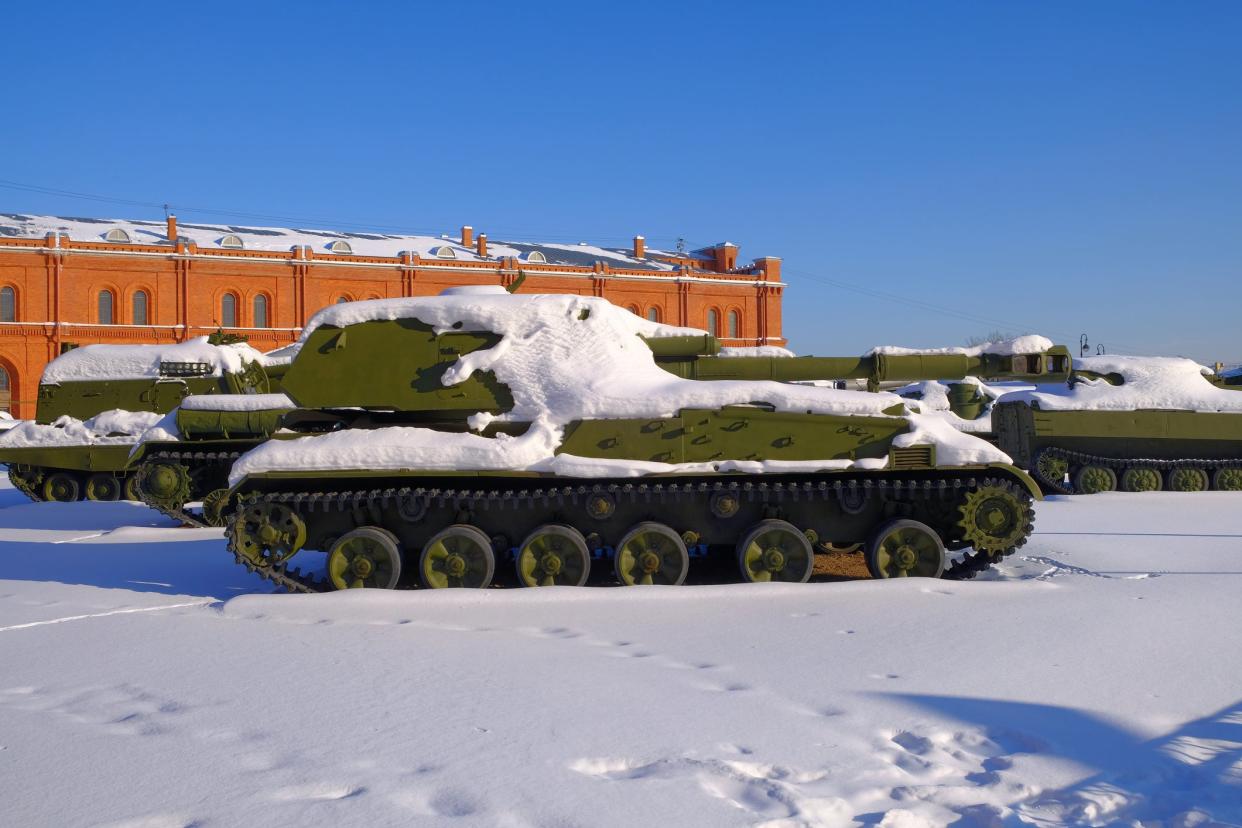'Meatgrinder' Report details how Russia is protecting its limited tanks

We all remember the opening days of the Russian invasion. Initially, it appeared that Russia might quickly sweep through Ukraine, but then Ukraine began bottlenecking and destroying the invaders. The Oryx tracker filled up with photos of dead equipment, especially tanks. Hundreds and then thousands showed up destroyed in photos and videos. The images got turned into jewelry and patches. And Russia had to pull Cold War-era tanks out of deep storage.
So why have Russian tank losses fallen? If older, crappier tanks with less trained crews now patrol the lines, why aren't even more dying?
The Royal United Services Institute sent out a report in May that, while dated, illuminates what is happening today. The top-line answer: Russia mostly stopped using tanks as tanks. (Side note: The report is titled Meatgrinder, which is such a great name for it.)
How Russian tanks worked in Ukraine
Like the West, Russia used armor, especially tanks, to punch holes in enemy lines and achieve "operational depth." Basically, when you hit the enemy, you want to disrupt their defensive operations as deep behind their lines as you can. If you can bypass some forces and cut off their resupply, interrupt their maneuvers, and break apart their support network, then they will collapse and be forced much further back as they try to set up a new defensive line.
It's an old concept, and there's a bit of debate over whether the Soviets invented the concept in the interwar period or the U.S. did in World War I. (This historian makes a good case for World War I America.)
Tanks are only one part of operational depth. They should be used in conjunction with aviation, special operators, paratroopers, conventional line units, and more. Aviation and missiles strike furthest, special operators can hit at any depth, then paratroopers and deep strike artillery, then tanks, then conventional artillery and standard or mechanized infantry.
But Russia's entire depth chart ran into problems throughout the war. Aviation fell back against better-than-expected Ukrainian defenses and a flow of missiles from the West. (Didn't help that Russia shot down some of its own fighters, then and now.) The Kremlin's special operators suffered heavy losses in the invasion and have never fully recovered. Ditto paratroopers, and both continue to suffer. They often act as emergency, defensive infantry even as Russia tries to re-constitute them. Deep-strike artillery had some success, at least.
And so Russian tanks, already deeply depleted by Ukraine's attacks, would have been some of the deepest striking assets if Russia tried to continue striking through operational depth. Russia lost tanks by the dozen even when aviation, commandos, and more were interfering with Ukrainian defenders.
So, Russia found a new way to use them.

How Russia is using tanks now
Basically, if you're used to World War II-era field guns, Russia now uses tanks largely as self-propelled field guns. Russian tanks roll up to positions—usually far behind the line—hide themselves with thermal camouflage and then use their guns as indirect artillery or direct-fire fire support.
This is not what tanks are really designed for, and most of the modern tanks are way overengineered for the mission. But it allows Russia to keep the tanks out of harm's way, and the guns on the tank can kill infantry from almost two miles away and Ukrainian armor from over a mile. Even the mocked, obsolete tanks can serve in this role.
Tanks often miss during indirect fire missions, but accepting a few misses from a tank barrel allows Russia to save artillery ammo and barrels. And better to miss a lot without losing the entire tank than to get a few kills and watch the tank, and its remaining ammo, blow up to a javelin hit.
And Russia does use the tanks in a third, mostly tank-like, way. It conducts raids. Doing so at dawn and dusk limits infrared trackers' ability to see them. That's when the tank and the ambient temperature are most similar. The raids typically see a small group of tanks conduct a lightning run against Ukrainian troops rotating off of the line.
Since the troop rotations complicate defense command and control, quick raids allow Russia to get in and out. According to RUSI, they show up, fire all their ammo at targets of opportunity as fast as they can, and then they escape.
Continued threats
Of course, the change in tactics reduces but does not eliminate Ukrainian threats against Russian tanks. Drones can still sniff out tanks and call artillery against them. An increase in aviation and rocket-artillery assets might allow Ukraine to risk some units hunting down remaining Russian tanks.
But the biggest threat comes from Ukraine's continued attempts to cut off Russian forces. Tanks, even parked, need a lot of fuel to run their optics and other systems. And they obviously can't hit anything without ammo. If Ukraine continues to limit Russian resupply, especially by isolating the south, it could capture or force Russia to destroy hundreds of tanks.

